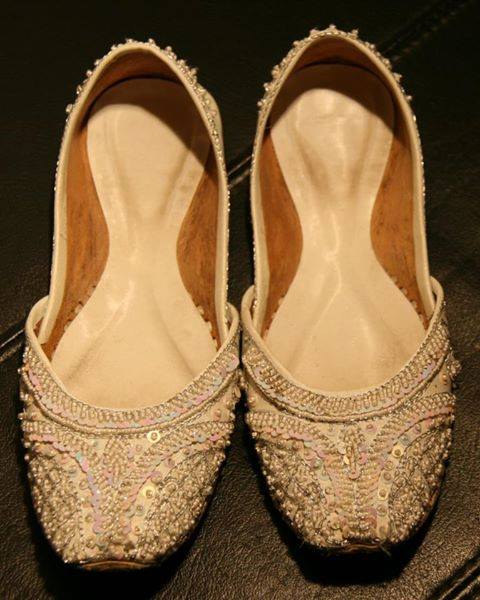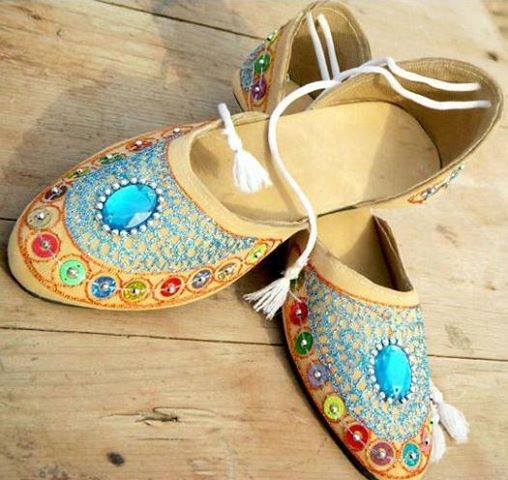Khussa is predominantly worn and made in Pakistan and India, while also made in some parts of China. However, Pakistan is renowned for making the finest khussas. This is attributed to our method of producing high quality leather and superior stitching by hand.
History
It can be said that the present day khussa alternately known as mojari or jutti has evolved from its predecessor that was worn centuries ago. At first they were simple shoes made of wood, possibly an influence of china. However they were not comfortable or feasible to wear in the cold weather. Later, as leather was easily available, people began making shoes from it. It was initially worn by the common man. Then during the 17th century, it was the Mughal King Jahangir who introduced the embellished version. Such a khussa was made of the best leather embedded with real gems, and embroidered beautifully with threads of real gold and silver. That is how it got its name Saleem Shahi, which was the nickname of Jahangir. It soon became associated with Nawabs, rajas and others. Later on, when synthetic thread was used it became more affordable and was worn by all classes. Some specimen’s are on display in the Lahore Museum.
Generally, khussas have always been made by the local cobbler in the villages, and used by both men and women. There is no difference between the right and left foot, so that is why they are worn interchangeably. Also, there are no exact sizes, therefore one would have to try on and see which fits. On average, a craftsman could prepare five shoes per month. So the landlords would place an order for their entire family and pay the cobbler through barter system in terms of wheat, rice etc at time of harvest, while the villagers would simply pay cash.
How They are Made
The outstanding feature is that they are completely made by the hand, i.e. the cutting, embroidery and stitching. The process of making a khussa includes vegetable tanning, curing of leather, cutting & sewing the insole, outsole, sole and vamp. The upper part and sole are joined together by paste and then stitched by hand using white cotton threads.
The cut of both left and right shoe are the same, however the embroidery is done on the leather before the shape of the khussa comes into form. To do the embroidery, a design cut out from a particular type of paper is pasted onto the leather. This design is made using a small chisel-like awl.
The quality and resilience of the shoes depends on the type of leather used, so the characteristics of a good khussa are: a) both upper and lower sole should be of the same color, b) the leather should appear to be thick c) it should be stiff (as you always have to break into a good leather shoe).
Earlier Types of Khussas

Khussas would be typified based on the specific leather that was used in making it or a distinctive design made at a specific place. For instance the ones made from goat skin were known as Saleem Shahi. The ones made from camel skin were known as Nagra. Khussas having filigree patterns were made at Wazirabaad, therefore called Wazirabaadi. Those who had embroidery done with a white metallic thread called tilla on specifically red, black or skin colored leather were called Shikaarpuri. It has also been called TalaKangi, Chakwali, Bahawalpuri, Qasoori etc. While Multani khussas were and are still considered the best in terms of workmanship as well as matchless designing. They are made by skilled craftsmen in small shops in the old city.
The Current Trend
Khussas are made in many cities of Punjab, such as Multan, Bhawalpur, Lahore, Sargoda, and Sheikhupura, while they are also made in some parts of Sindh. These are available in all khussa shops throughout the country. Also for many years they are being exported and have succeeded in creating quite a niche for themselves. And since now a huge variety can be found online, that has given sales another boost, nationally and internationally.
These days khussas can be made on order and you can even specify your own design. While instead of traditional leather a wide range of other fabrics are being used to make them such as velvet, cotton, silk, jaamawaar etc.
Men’s Khussas
The distinguishing feature of men’s khussas is that they have a sharp extended tip called a nok curved upwards, the back covers the ankle and usually the upper part is M-shaped, and half the top of foot is bare. These are usually worn on occasions. While the others commonly referred to as juttis which are worn casually, have a flat front and a rounded upper part and lesser part of the foot is uncovered.
In the past, khussas for men were quite simple. Even the ceremonial ones were made in a few typical designs. Yet now they are elaborately made in a variety of colors with different forms of embroidery and materials used. Khussas are also available for children and young boys.
Women’s Khussas

A woman’s khussa is narrower and one style is that the upper curve is higher, so that half of the fingers are visible. While another style is that the upper curve is low and covers more of the foot. Following tradition they are made flat like men, but changing fashions have led to khussa slippers (back-open khussas) and also ones with a small heel.
Hundreds of designs are available in a multitude of the most vibrant colors. These designs have eye-catching embroidery consisting of dabka, tilla, kora etc and are also decorated with different types of beads, sequins, mirrors, pearls, shells, brass nails, bells as well as gotta, ribbons, mukesh and velvet which accentuate their beauty.
As slacks and skinny jeans are very much in these days and khussas are the traditional answer to pumps and ballerina flats; they have become extremely popular again with girls and women of all ages. Also the chooridar pyjama is back in fashion, and so fancy khussas are the obvious choice for girls. Moreover brides are getting ones made that are exactly matching to their dress. Khussas for little girls are also available.
Interestingly; until the early 1990s, there had been really no separate khussa for women. It is said that the most popular khussa shop in Liberty Market, Lahore known as Khussa Mehal was the one which actually introduced it. With nearly thirty years into the business, they are very innovative in their designing, and can be considered something of a designer shoe store. Another novelty is that they have special khussas made which showcase the distinctive embroidery of each province.
So Khussas truly symbolize our cultural diversity and ethnicity. They are timeless classic footwear that have always been part of our fashion scene, and with their present status will continue to be so. And as they are still made in their original form; we often get the opportunity to wear a piece of our history even today.
